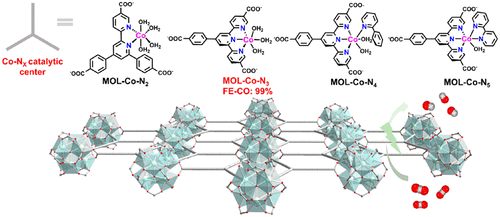我室汪骋教授在 JACS 上发表论文:Tunable Cobalt-Polypyridyl Catalysts Supported on Metal–Organic Layers for Electrochemical CO2 Reduction at Low Overpotentials
文章链接:https://pubs.acs.org/doi/10.1021/jacs.0c10719
摘要:The Co center is active in electrochemical CO2 reduction (CO2RR), and its activity can be tuned by changing its coordination environment. However, the coordination number around the Co center cannot be readily changed in homogeneous systems owing to bimolecular decomposition of reduced low-coordinate Co species. Herein we report the systematic tuning of N atom numbers from 2 to 5 in the first coordination sphere around Co centers supported on two-dimensional metal–organic layers (MOLs) for the electrochemical CO2RR. The N atoms come from a combination of bipyridine, terpyridine, and phenylpyridine ligands. The Co centers are isolated and stabilized on the MOL to prevent bimolecular decomposition. All of the catalysts, denoted MOL-Co-Nx (x = 2–5), are active in reducing CO2 to CO electrochemically, but their activities are highly dependent on the number of coordinating N atoms. MOL-Co-N3 showed the highest current density of 2.3 A mg–1 with a CO Faradaic efficiency of 99% at an overpotential of only 380 mV. Density functional theory calculations attribute the high activity of the Co-N3 center to a balance of ligand field strength and open coordination site: the high ligand field strength promotes back-bonding, while the open coordination site allows HCO3– assistance, both of which accelerate C–O cleavage. MOLs thus provide a unique platform to systematically study the relationship between the coordination environment and the reactivity of open metal sites in electrocatalysis.
